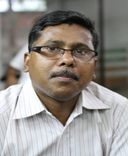Slum-dwellers bring pride, revenues for Bangladesh |
Banarsi artisans struggle amid tides of market economy
Nazir Ahmed (39) may leave Bangladesh in a lifetime but his handiwork remains the country’s unrivaled flag career in six continents.
Ahmed is the third generation of Urdu-speaking Muslims who weave Banarsi sarees – a traditional, colourful female dress in Bangladesh, India, Nepal and Sri Lanka. While this hand-made attire of Jamdani or Katan variety is an integral part of fashion-conscious women’s wardrobe, the common femalefolk wears its cheaper and more robust version.
Mirpur Banarsi saree producers proudly claim that their handiwork has been a special choice of leading icons of the Mumbai film industry, blockbuster film Devdas exhibiting a vast variety of Banarsi sarees from Mirpur.
Centuries ago, queens and princesses wore gold-embroided sarees. Every girl today expects a beautiful saree for her wedding from parents or in-laws, more the better. Locally, the Benarasi sarees are sold anywhere between Taka 20,000 to Taka 200,000.
The Banarsi saree-weaving artisans don’t originate from Bangladesh. The 1942 worst famine in the Indian sub-continent forced first migration of the Bihari Muslims to Dhaka, now capital city of Bangladesh .
Ahmed’s great grandfather Azimullah Khan came to Mirpur area with his loom and two brothers Kallu Khan and Mallu Khan. Some 40 other Bihari migrant families joined them to start a cottage industry of Banarsi sarees, already recognized as embodiment of artisanship and finesse.
Hindustan’s geography changed in 1947 and East Bengal became East Pakistan, where Muslims from adjoining Hindu majority areas migrated for equal social status and religious rights.
Since predominant majority spoke Bangla language and had its distinctive Bengali culture, Urdu-speaking migrants from Bihar became an outcaste nicknamed ‘ stranded Pakistanis’ after creation of December 16, 1971. The Bihari community remained without citizenship till 2006 amid the worst living conditions in the South Asian region by far.
The Election Commission enrolled Urdu-speaking Biharis born after 1972 as voters only after a high court verdict of May 18, 2008. But for thousands of Biharis, the right to travel abroad still remains a far cry.
Many artisans like his father Manzoor Ahmed in Mirpur were tortured during the Liberation War for allegedly siding with the Pakistani armed forces. He was forced to donate his small piece of land for a Mosque in Mirpur.
Since then, he recalls that most families have been living either in rented houses or in refugee camps ironically named ‘Non-local Relief Camp’ in Mirpur Benarosi Pally area.
Born and bred in Dhaka, Ahmed operates a factory of 30 looms but lives in a small tin-shed building, with wife Shehnaj Aktar, daughter Nehanur (7) and son Zunayed (4). Most families sleep and work on a loom inside their shabby slums along narrow, sewage-swamped streets.
Semi-literate Ahmed firmly believes learning Bangla language and education can change their God-forsaken area in the long run. Ahmed proudly says: “My children not only go to school but also fluently speak Bangla.”








 Sadrul Hasan is a Dhaka-based journalist with 23 years of experience to his credit. Currently, he is a special correspondent for United News of Bangladesh. He has reported for the wire service from China, Pakistan, India, Malaysia and Thailand.
Sadrul Hasan is a Dhaka-based journalist with 23 years of experience to his credit. Currently, he is a special correspondent for United News of Bangladesh. He has reported for the wire service from China, Pakistan, India, Malaysia and Thailand.
Post new comment